Renault Captur
Renault Captur is the name of two different subcompact crossovers manufactured by the French automaker Renault.[1][3] The production version of the first one, based on the B platform, made its debut at the 2013 Geneva Motor Show and started to be marketed in France during April 2013.[4] The Captur Concept was first shown at the 2011 Geneva Motor Show.
| Renault Captur | |
|---|---|
.jpg) | |
| Overview | |
| Manufacturer | Renault |
| Also called | Renault Kaptur (CIS) |
| Production | 2013–present |
| Body and chassis | |
| Class | Subcompact crossover[1] |
| Body style | 5-door SUV[2] |
| Chronology | |
| Predecessor | Renault Modus |
In Russia, a different and longer car, based on the B0 platform, with the same styling as the first but an extended wheelbase, greater ground clearance and four-wheel-drive has been available as the Renault Kaptur since March 2016.[5] A localised version of the same car has been offered with both front and four wheel drive in Brazil since the beginning of 2017, being badged as the Renault Captur.[6] This model was also introduced to India in November 2017.
First generations
There are two different versions of the first generation Captur each built on its own platform. The B platform version was produced between 2013 and 2019 and the B0 platform version started production in 2016.
Renault Captur (B platform; 2013)
| First generation (B platform) | |
|---|---|
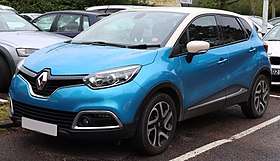 | |
| Overview | |
| Also called | Renault Samsung QM3 (South Korea) |
| Production | 2013–2019 |
| Assembly | Spain: Valladolid (Renault Spain) Malaysia: Kuala Lumpur (TCMA) |
| Body and chassis | |
| Layout | Front-engine, front-wheel-drive |
| Platform | Renault B platform |
| Related | Renault Clio Nissan Juke |
| Powertrain | |
| Engine | |
| Transmission | 5-speed manual 6-speed automatic |
| Dimensions | |
| Wheelbase | 2,606 mm (102.6 in) |
| Length | 4,122 mm (162.3 in) |
| Width | 1,778 mm (70.0 in) |
| Height | 1,567 mm (61.7 in) |
.jpg)
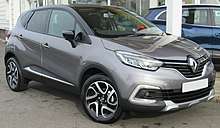
The car is based on the fourth generation Clio[7] and incorporates design lines from the homonymous concept,[8] as part of Renault's renovated design strategy developed by Laurens van den Acker.[9] It has various customisation options for the interior and the exterior.[7]
The car suspension is made up of MacPherson struts on front and a twist-beam axle on rear. Brakes are discs on front and drums on rear.[10]
The Captur has some new elements, such as a large drawer-like glovebox that is more easily reachable by the driver, instead of a conventional glove compartment in left hand drive models.[3]
The Captur originally had four trim levels in the UK: Expression, Expression+, Dynamique Media Nav and Dynamique S Media Nav. In December 2013, Renault added a top-of-the-range Signature trim and, in 2015, the Iconic.[11] In 2018, the Captur added the sportier S-edition. [12] As standard, it has parking sensors and voice activation for certain functions.[13] In some versions, it also adds removable seat covers with zippers,[9] a new Renault satellite navigation system with touchscreen,[14] reverse cameras and automated head lamps and windscreen wiper.[13]
The Captur achieved a five star rating at the 2013 EuroNCAP tests.[15] Between its standard safety equipment, it has three point seat belts, two airbags, cruise control, speed limiter, ESC, ABS and audible and visual seat belt reminder warnings.[13] Renault Captur is also equipped with Hill-Start assist feature.[16]
Facelift
In May 2017, Renault introduced a facelifted Captur with slightly revised interior and exterior designs, more customisation options and improved equipment.[17]
Sales
Despite being on the market for less than a full year, it managed to rank third in the European small crossover segment for 2013, with just over 84,000 sales, behind the Nissan Juke and the Dacia Duster, and it was the segment's best seller in the last quarter of 2013.
At the end of 2015, Renault Captur was ranked 14th out of the 20 most sold cars in Europe with 195,323 units.[18]
Engines
The Captur is powered by a range of petrol and diesel engines.[19][20][12][10][21]
| Engine | Code | Type | C. | Displacement | Power | Torque | 0-100 km/h (0–62 mph) | Combined Consumption | CO 2 emissions |
|---|---|---|---|---|---|---|---|---|---|
| Petrol engines | |||||||||
| Energy TCe 90 Stop & Start | H4Bt 400 | Turbo Multi-point fuel injection | 3 | 898 cc | 66 kW (90 hp) at 5,250 rpm | 135 N⋅m (100 lb⋅ft) at 2,500 rpm | 13 s | 5 l/100 km (56 mpg‑imp) | 115 g/km |
| H4Bt 408 | 66 kW (90 hp) at 5,000 rpm | 135 N⋅m (100 lb⋅ft) at 2,250 rpm | 13.1 s | 5.1 l/100 km (55 mpg‑imp) | 114 g/km | ||||
| Energy TCe 120 Auto EDC/TCe 120 Stop & Start | H5Ft 403 | Turbo direct injection | 4 | 1,197 cc | 87 kW (118 hp) at 4,900 rpm | 190 N⋅m (140 lb⋅ft) at 2,000 rpm | 10.9 s (AT) | 5.5 l/100 km (51 mpg‑imp) | 125 g/km |
| H5Ft 412 | 87 kW (118 hp) at 5,000 rpm | 205 N⋅m (151 lb⋅ft) at 2,000 rpm |
| 5.6 l/100 km (50 mpg‑imp) | |||||
| Energy TCe 150/Energy TCe 150 Auto EDCb | H5Ht | Turbo direct injection | 1,330 cc | 115 kW (156 hp) at 5,500 rpm | 250 N⋅m (184 lb⋅ft) at 1,600–3,600 rpm |
|
|
| |
| Diesel engines | |||||||||
| Energy dCi 90 Stop & Start |
| Turbo common rail injection | 4 | 1,461 cc | 66 kW (90 hp) at 4,000 rpm | 220 N⋅m (162 lb⋅ft) at 1,750 rpm | 13.1 s | 3.7 l/100 km (76 mpg‑imp) | 95 g/km |
| Energy dCi 90 Auto EDC | K9K 609 | 13.8 s | 3.9 l/100 km (72 mpg‑imp) | 103 g/km | |||||
| K9K 629 | 13.9 s | ||||||||
| Energy dCi 110 Stop & Starta | K9K 636 | 81 kW (110 hp) at 4,000 rpm | 260 N⋅m (192 lb⋅ft) at 1,750 rpm | 11.4 s | 3.9 l/100 km (72 mpg‑imp) | 98 g/km | |||
| Notes | |||||||||
| |||||||||
Awards
The Captur won What Car? 2014 “Best Small SUV Less Than £16,000”.[22] It was also named Voiture de l'Année 2013 (2013 Best Car) by the French Association of Automotive Press.[23]
Renault Samsung QM3
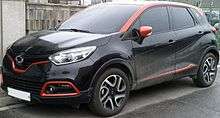
The Renault Samsung QM3 is a badge engineered version of the Captur, launched in South Korea at the Seoul Motor Show in April 2013,[24][25] shortly after its European counterpart was revealed at the Geneva Motor Show. The QM3 was officially released on 6 December 2013, and the initial 1,000 cars allocated to South Korea sold out within seven minutes.[26]
The QM3's dimensions and wheelbase are identical to the Captur's, while the engine range is limited to a single dCi 90 four cylinder diesel and dual clutch transmission.[27]
Awards
The QM3 was voted Best Car at the 2013 Seoul Motor Show.[25] and was chosen 2014 “SUV of the Year” by the newspaper JoongAng Ilbo in March 2014.[28]
Renault Captur/Kaptur 'Global Access' (B0 platform; 2016)
| First generation (Global Access) | |
|---|---|
.jpg) | |
| Overview | |
| Also called | Renault Kaptur (CIS) |
| Production | 2016–present |
| Assembly | Brazil: São José dos Pinhais (Renault Brazil) Russia: Moscow (Renault Russia) India: Chennai (Renault India) |
| Body and chassis | |
| Layout | Front-engine, front-wheel-drive four-wheel-drive |
| Platform | Renault/Dacia B0 platform Renault/Dacia B0+ platform (2020–present) |
| Related | Dacia Duster (HS) Nissan Kicks (P16) Renault Arkana (B0+ platform) |
| Powertrain | |
| Engine | |
| Transmission | 5-speed manual 6-speed manual 4-speed automatic CVT Jatco CVT7 CVT Jatco CVT8 |
| Dimensions | |
| Wheelbase | 2,673 mm (105.2 in) |
| Length | 4,333 mm (170.6 in) (Russia) 4,329 mm (170.4 in) (Brazil, India) |
| Width | 1,813 mm (71.4 in) |
| Height | 1,613 mm (63.5 in) (Russia) 1,619 mm (63.7 in) (Brazil, India) |
_(cropped).jpg)
A larger car with a similar styling as the original Captur but with a larger wheelbase and ground clearance is being produced by Renault to capture emerging markets. This model is referred internally by Renault as the Captur Global Access (Captur GA).[29] Compared to the B platform-based Captur, the Captur GA is cheaper to build as it is based on the first generation Dacia Duster platform instead of the fourth generation Clio while offering larger cabin space.[30]
The Captur GA was first introduced in Russia and the neighbouring CIS countries in 2016, badged as the Renault Kaptur. Change of the naming was explained by the difficulties of the correct pronunciation of the original "Captur" name in the Russian language. The Renault Kaptur is manufactured by the Renault Russia plant since April 2016.[31] The front wheel drive version of this car is powered by the 1.6 litre engine and has manual gearbox or CVT, while all wheel drive versions have the 2.0 litre engine and manual or automatic (four-speed) gearbox.
A localised Brazilian version was introduced in the beginning of 2017, badged as the Renault Captur.[6] The Brazilian version has manual (five-speed), CVT and automatic (four-speed) gearboxes.[32] That same year, the Brazilian Captur was named as Best Design by Americar (automotive press association of Latin America).[33] The car got a 4-star safety rating in the 2017 Latin NCAP tests.[34] The Brazilian-made Captur GA is exported throughout Latin America.
The car is available in the Indian market since 2017, also badged as Captur.[30] Production and pre orders started in September 2017.[35][36] It is also offered with a 1.5 L K9K diesel engine until April 2020, when it was discontinued due to the implementation of Bharat Stage 6 emission standards.[37] Advertising videos from Renault India got a negative reception in some forum and media outlets for allegedly "misinform" customers on the car awards by mentioning the ones received by the B platform version.[38]
The Captur GA is very closely related with the Indian market Nissan Kicks (P16), as the Indian Kicks is essentially a restyled Captur GA while sharing the same chassis, engines and other parts to cut costs. Both are currently built at the same manufacturing plant jointly owned by Renault and Nissan in Chennai, India.
Facelift
In May 2020, Renault Russia launched the facelifted Kaptur.[39][40] Apart from several subtle exterior and interior updates, the car is now engineered above the B0+ platform instead of the B0 for better ride quality, resulting in more than 55% components being updated.[41] The hydraulic power steering was ditched in favour of the modern electric power steering, which in turn allowed the steering column to be adjusted for reach.[42] The Kaptur received a new 1.3 L H5Ht petrol turbo engine, replacing the 2.0 L F4R naturally aspirated petrol engine.[43]
Engines
At first, the B0 model did not have diesel engines. It mounts engines either burning petrol (for Russia-assembled vehicles) or a mix of petrol/ethanol (for Brazil-assembled vehicles).[32][44] The India-assembled Captur had a diesel engine as an option.[36]
| Engine | Type | C. | Displacement | Power | Torque |
|---|---|---|---|---|---|
| Petrol engines | |||||
| 1.3 petrol1 | Direct injection | 4 | 1,332 cc | 150 hp (110 kW) | |
| 1.5 petrol2 | Direct injection | 4 | 1,498 cc | 106 hp (78 kW) at 5,600 rpm | 142 N⋅m (105 lb⋅ft) at 4,000 rpm |
| 1.6 petrol1 | Direct injection | 4 | 1,598 cc | 114 hp (84 kW) at 5,500 rpm | 156 N⋅m (115 lb⋅ft) at 4,000 rpm |
| 2.0 petrol1 | Direct injection | 4 | 1,998 cc | 143 hp (105 kW) at 5,750 rpm | 195 N⋅m (144 lb⋅ft) at 4,000 rpm |
| Petrol/ethanol engines (Brazil) | |||||
| 1.6 petrol/ethanol | Direct injection | 4 | 1,597 cc |
| 159 N⋅m; 117 lb⋅ft (16.2 kg⋅m) at 4,000 rpm |
| 2.0 petrol/ethanol | Direct injection | 4 | 1,998 cc |
|
|
| Diesel engines | |||||
| 1.5 diesel1 | Turbo common rail injection | 4 | 1,461 cc | 110 hp (81 kW) at 4,000 rpm | 240 N⋅m (177 lb⋅ft) at 1,750 rpm |
| Notes | |||||
| |||||
Limited edition
In Mexico, the Bose limited edition was launched in early December 2019. It is based on the Iconic trim line, and only available in a grey colour, with an option of a black or white roof option.[45]
Second generation (2020)
| Second generation | |
|---|---|
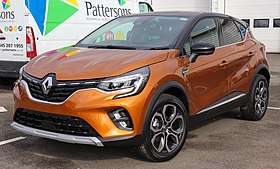 | |
| Overview | |
| Production | 2019–present |
| Assembly | Spain: Valladolid (Renault Spain) China: Wuhan (Dongfeng Renault) |
| Body and chassis | |
| Layout | Front-engine, front-wheel-drive |
| Platform | CMF-B[46] |
| Related | Renault Clio Nissan Juke |
| Powertrain | |
| Engine |
|
| Transmission | 5-speed manual automatic CVT Gearbox |
| Dimensions | |
| Wheelbase | 2,630 mm (103.5 in) |
| Length | 4,230 mm (166.5 in) |
| Width | 1,800 mm (70.9 in) |
| Height | 1,593 mm (62.7 in) |
The second generation Captur debuted in 2019, based on the newer CMF-B platform which is the same platform that underpins the Renault Clio 5 and the second generation of the Nissan Juke.[46]
It would be sold with its international Captur name from the first half of 2020 in South Korea, instead of being rebadged as QM3.[47]
.jpg)
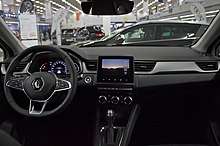
Captur concept
| Captur concept | |
|---|---|
.jpg) | |
| Overview | |
| Manufacturer | Renault |
| Production | 2011 (Concept car) |
| Designer | Julio Lozano |
| Body and chassis | |
| Class | Mini SUV (J) |
| Body style | 2-door SUV |
| Layout | Front-engine, front-wheel-drive |
| Doors | Butterfly |
| Related | Renault Clio IV Nissan Qazana |
| Powertrain | |
| Engine | Twin turbocharged 1.6l dCi |
| Dimensions | |
| Curb weight | 1,300 kg (2,866 lb) |
A concept car named Renault Captur was unveiled by Renault at the 2011 Geneva Motor Show.[48] It was shown with the Renault Samsung badge at the 2012 Busan Motor Show.
The Captur is a mini SUV, and it is the second of six concept cars showing Renaults future design directions. The first was the Renault DeZir. It was designed by Julio Lozano under the leadership of Renault's design chief Laurens Van den Acker.[49]
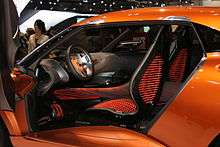
Technical details
It is based on the same platform as its partner Nissan's Juke. The Captur is powered by a twin-turbocharged version of the 1.6 L dCi "Energy" engine which will be rolled out among Renault and Nissan models during 2011. The engine produces 158 bhp (118 kW; 160 PS) and 280 lb⋅ft (380 N⋅m) of torque, and the Captur can accelerate from 0-62 mph (100 km/h) in 8.0 seconds a low 99 g/km of CO2 emission figure and a top speed of 130 mph (209.2 km/h).[50]
The car is made from carbon fibre, has butterfly doors[51] and has a removable roof. It weighs 1,300 kg (2,866 lb) and features large 22 inch wheels. Despite its crossover appearance, the Captur is front-wheel drive and features Renault's new ‘RX2’ mechanical self-locking differential to transfer the available torque to the driven wheel with the most grip.[52]
Sales
| Calendar Year | Global sales | |
|---|---|---|
| Captur | Captur GA | |
| 2016[53] | 243,797 | 15,160 |
| 2017[53] | 232,733 | 62,147 |
| 2018[54] | 230,070 | 78,907 |
| 2019[54] | 239,332 | 69,812 |
References
- "Renault Captur review". Auto Express. 11 June 2018. Retrieved 20 October 2018.
- http://www.carfolio.com/specifications/models/car/?car=329109
- "Geneva motor show: Renault Captur". autocar.co.uk. Autocar. Retrieved 2 May 2013.
- Gain, Bruce (23 April 2013). "Renault Captur joins crowded segment". europe.autonews.com. Automotive News Europe. Retrieved 2 May 2013.
- "New Renault Kaptur Unveiled In Russia; Might Come to India". CarAndBike.com. 31 March 2016. Retrieved 16 April 2016.
- "Renault Captur brasileiro é maior que o homônimo europeu e aproveita a base do Duster" [The Brazilian Renault Captur is larger than its European namesake and uses the Duster base]. Extra. Grupo Globo. 21 February 2017. Retrieved 28 September 2017.
- Wilkinson, Leo (26 April 2013). "Renault Captur review". telegraph.co.uk. The Daily Telegraph. Retrieved 2 May 2013.
- "Renault Captur". Renault. Retrieved 2 May 2013.
- Lyndon, Neil (9 November 2013). "Renault Captur Dynamique TCe 90 review". telegraph.co.uk. The Daily Telegraph. Retrieved 26 February 2013.
- "New Renault Captur" (PDF). Renault UK. Retrieved 6 May 2018.
- Haining, Chris. "Used Renault Captur buying guide: 2013-present (Mk1)". Car Buyer. Retrieved 6 May 2018.
- "Renault Captur S-Edition : 150 ch sous le capot !" [Renault Captur S-Edition: 150 hp under the bonnet]. Auto Plus (in French). Retrieved 6 May 2018.
- "A 15th five-star Euro NCAP rating for Renault thanks to Renault Captur!". Renault. Retrieved 25 March 2014.
- Ward, Piers (25 April 2013). "First drive: the Renault Captur". topgear.com. Top Gear. Retrieved 26 February 2013.
- "Renault Captur" (PDF). euroncap.com. EuroNCAP. p. 1. Archived (PDF) from the original on 24 September 2013. Retrieved 23 March 2014.
- "Renault Captur Specs". CarBay Malaysia. Archived from the original on 26 December 2015. Retrieved 4 November 2015.
- "Facelifted Renault Captur launches with starting price of £15,355". autocar.co.uk. Autocar. Retrieved 28 September 2017.
- http://www.best-selling-cars.com/europe/2015-full-year-europe-20-best-selling-car-models/
- "Technical specifications. Renault Captur". Renault. 13 April 2013. Archived from the original on 25 February 2014. Retrieved 23 February 2014.
- "Renault Captur brochure" (PDF). capturownersclub.co.uk. 1 January 2014. Retrieved 23 February 2014.
- "Motorisations Captur" [Captur engines] (in French). Renault France. Retrieved 6 May 2018.
- "What Car? Awards 2014 - Small SUV - Best Buy less than £16k". What Car?. Retrieved 24 February 2014.
- "Renault: distingué pour Renault Captur et Dacia" [Renault awarded for Renault Captur and Dacia]. bourse.lefigaro.fr (in French). Le Figaro. 14 March 2014. Retrieved 15 March 2014.
- "QM3's iconic design draws attention". koreatimes.co.kr. The Korea Times. 26 December 2013. Retrieved 22 February 2013.
- "Renault releases Captur as Samsung QM3 in Korea, receives 5,000 orders". Carscoops.com. 3 December 2013. Retrieved 22 February 2014.
- "... The official launch of Renault Samsung QM3 · SUV Sedan combines the advantages".
- "Renault Samsung Motors QM3". Renault Samsung Motors. Retrieved 22 February 2014.
- "And the winners are…". koreajoongangdaily.joins.com. Korea JoongAng Daily. 28 March 2014. Archived from the original on 29 March 2014. Retrieved 2 February 2014.
- https://group.renault.com/wp-content/uploads/2019/04/factsfigures-2018.pdf
- Priyadarshan Bawikar Author (14 July 2017). "2017 Renault Captur Test Drive & Expert Review". Autocar India. Retrieved 20 October 2018.
- "Renault Kaptur". Wroom.ru. Retrieved 20 October 2018.
- "Novo Renault Captur. Ficha Técnica" [New Renault Captur. Technical specifications] (in Portuguese). Renault do Brasil. Retrieved 29 September 2017.
- "Prêmio Americar anuncia os melhores veículos da América Latina; confira os vencedores" [The Americar award announces the best vehicles of Latin America: check the winners]. O Popular. 18 November 2017. Retrieved 6 May 2018.
- "Renault Captur" (PDF). Latin NCAP. Retrieved 6 May 2018.
- "Renault Captur available for sale in India" (Press release). Renault. Retrieved 29 September 2017.
- Mukherjee, Sharmistha (24 September 2017). "Renault Captur unveiled in India, now open for bookings". The Economic Times. Retrieved 3 October 2017.
- "Renault Duster And Captur Diesel SUV To Be Discontinued In 2020". ZigWheels.com. Retrieved 2020-05-07.
- "How Renault India's new ad for Captur misinforms buyers". Zee Media Corporation. 4 October 2017. Retrieved 4 October 2017.
- "2020 Renault Captur facelift breaks cover". Autocar India. Retrieved 2020-05-22.
- "Обновлённый Renault Kaptur подорожал всего на 20 тысяч и получил турбомотор". www.e1.ru (in Russian). 2020-05-22. Retrieved 2020-05-22.
- "2021 Renault Captur (facelift) revealed, is based on a new platform". indianautosblog.com. Retrieved 2020-05-22.
- "Новый Renault Kaptur для России. Что изменилось? :" [New Renault Kaptur for Russia. What changed?]. Autonews (in Russian). Retrieved 2020-05-22.
- "Новый Renault Kaptur для России: названы цены и оснащение" [New Renault Kaptur for Russia: prices and equipment are announced]. Motor1.com (in Russian). Retrieved 2020-05-22.
- "Renault Kaptur" (PDF) (in Russian). Renault Russia. p. 17. Retrieved 29 September 2017.
- https://www.motorpasion.com.mx/industria/renault-captur-bose-mexico
- "2019 Renault Captur (European spec) rendered, arriving in 2019". Indianautosblog.com. Retrieved 20 October 2018.
- "르노삼성 'SM 3·5·7' 단종…'XM3·캡처·QM6' SUV 라인업으로 빈자리 채운다" [Renault Samsung's SM3, SM5 and SM7 discontinued… XM3, Captur, QM6 SUVs lineup to fill the gap]. ETnews.com (in Korean). 9 January 2020. Retrieved 16 January 2020.
- "Auto Express February 2011". Autoexpress.co.uk. Retrieved 20 October 2018.
- "Renault Captur concept car". Retrieved 15 July 2015.
- Autocar. "Geneva motor show 2011: Renault Captur crossover". Retrieved 15 July 2015.
- "Captur Concept | Concept Cars | Discover Renault | Renault UK". Passion for Life. Retrieved 2019-08-07.
- "Renault Captur concept car (2011) at 2011 Geneva motor show". CAR Magazine. Retrieved 15 July 2015.
- https://group.renault.com/wp-content/uploads/2018/03/march-2018-edition-facts-figures.pdf
- https://group.renault.com/wp-content/uploads/2020/04/facts-figures-2019.pdf
External links
| Wikimedia Commons has media related to Renault Captur. |
- Official website(France)
- Official website (UK)
- Official website (Renault Samsung QM3)